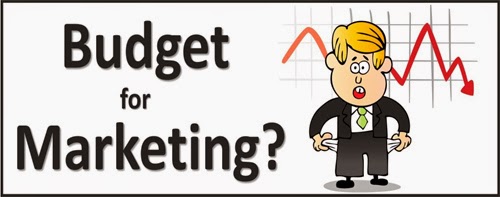Whether you run a small business or a big corporation, I would say that marketing is essential to your profitability and growth. Yet many small businesses don’t allocate enough money to marketing or, worse, spend it haphazardly. Marketing Budget is considered an important part of your marketing strategy. Your marketing budget will include all of the prices that you expect to pay for each type of advertising you do. This would include graphic and web design, printed materials, website development, ongoing maintenance and search engine optimization and all Social Media. It would also include radio and commercials, trade shows, advertisements in newspapers and other publications, mailings, etc.
There are many ways to create a marketing budget. Here are a few popular ones, with advantages and disadvantages.
1. Fixed Amount or % of Overall Budget. This is easy to do; consequently, it's one of the most common methods. At the beginning of the fiscal quarter or year, a company determines how much it will spend on marketing. To determine this amount, they might use industry averages.
There are many ways to create a marketing budget. Here are a few popular ones, with advantages and disadvantages.
1. Fixed Amount or % of Overall Budget. This is easy to do; consequently, it's one of the most common methods. At the beginning of the fiscal quarter or year, a company determines how much it will spend on marketing. To determine this amount, they might use industry averages.
For example, movie studios generally spend an amount equal to 30% of the film's
production budget, so for a $1 million movie, the marketing budget might be
$300,000.
Aside from being quick and easy, the advantage of this kind of budget is that
the marketing department doesn't have to ask for money every time they want to
spend it. (Since most companies consider marketing an expense, the answer the
marketing department usually gets when they ask for more money is
"no.")
One other advantage: Knowing how much money you have in advance also helps you plan campaigns.
The disadvantage of this kind of budgeting: it's completely nonstrategic since it offers no flexibility. No one can truly predict what kind of challenges the market will offer, or what this particular product might need. For example, one movie gets a positive critical review, so it needs less advertising. Another gets a poor review (or the critic refuses to review it at all), necessitating more advertising.
Another issue is what the competition is doing. If you're in a highly competitive market, then you might need to spend more money on marketing than if you're in a stable, peaceful market.
2. % of Sales. To ensure a steady source of marketing funds without plunging the company into a deficit, some companies allocate a fixed percentage of sales to marketing. For example, a company might say 30% of all sales will be used for marketing, so if the company makes $500,000, then $150,000 is given to the marketing department. That way, marketing never spends more than the company makes.
The problem, of course, is that this model cannot be used by a company that's just starting or otherwise has no sales at all.
There's a more critical problem: A company should actually spend MORE money on marketing when it's struggling, and less when it's successful. This model says the opposite. Because of this model, many companies cut their marketing budgets during a recession, when they should be increasing their marketing to grab market share from weak competitors. If an entire industry adopted this model, then successful companies would become even more successful (since they would spend more and more money on marketing) while struggling ones would fail (since they would spend less than less).
Finally, basing the marketing budget on a variable number makes planning extremely difficult.
3. Goal-Based Budgets. This is more complex, and requires a lot of data, so it's not as widely used. The key advantage of this method is that it helps convince managers and clients to spend the money.
It starts with an ambitious but realistic goal. While some managers say, "Let's just do something and see what happens," as MBA's, you're expected to have a goal. If you're working with a new company or in a turbulent industry, then such a goal might be difficult to predict. But perhaps you can find a competitor or similar company with more experience and base your goals on their results. I would also suggest starting with short term goals -- perhaps just a month -- then slowly extrapolate from there.
Let's use a really simplified, fictitious example of a goal-based budget:
Let's say your goal is to sell 5,000 computers for $1,000 each -- a total sales of $5,000,000. Now, unless you simply want to liquidate inventory or steal market share, you wouldn't want to spend more than $5,000,000 on marketing to achieve those sales. So you know your limit -- and that's more than most companies know when they begin marketing.
When any business owner can effectively analyze and fund the sources of business success, the business and its revenue will grow. A small business marketing budget can be a powerful tool to put one in the driver’s seat of how to determine that growth and success
One other advantage: Knowing how much money you have in advance also helps you plan campaigns.
The disadvantage of this kind of budgeting: it's completely nonstrategic since it offers no flexibility. No one can truly predict what kind of challenges the market will offer, or what this particular product might need. For example, one movie gets a positive critical review, so it needs less advertising. Another gets a poor review (or the critic refuses to review it at all), necessitating more advertising.
Another issue is what the competition is doing. If you're in a highly competitive market, then you might need to spend more money on marketing than if you're in a stable, peaceful market.
2. % of Sales. To ensure a steady source of marketing funds without plunging the company into a deficit, some companies allocate a fixed percentage of sales to marketing. For example, a company might say 30% of all sales will be used for marketing, so if the company makes $500,000, then $150,000 is given to the marketing department. That way, marketing never spends more than the company makes.
The problem, of course, is that this model cannot be used by a company that's just starting or otherwise has no sales at all.
There's a more critical problem: A company should actually spend MORE money on marketing when it's struggling, and less when it's successful. This model says the opposite. Because of this model, many companies cut their marketing budgets during a recession, when they should be increasing their marketing to grab market share from weak competitors. If an entire industry adopted this model, then successful companies would become even more successful (since they would spend more and more money on marketing) while struggling ones would fail (since they would spend less than less).
Finally, basing the marketing budget on a variable number makes planning extremely difficult.
3. Goal-Based Budgets. This is more complex, and requires a lot of data, so it's not as widely used. The key advantage of this method is that it helps convince managers and clients to spend the money.
It starts with an ambitious but realistic goal. While some managers say, "Let's just do something and see what happens," as MBA's, you're expected to have a goal. If you're working with a new company or in a turbulent industry, then such a goal might be difficult to predict. But perhaps you can find a competitor or similar company with more experience and base your goals on their results. I would also suggest starting with short term goals -- perhaps just a month -- then slowly extrapolate from there.
Let's use a really simplified, fictitious example of a goal-based budget:
Let's say your goal is to sell 5,000 computers for $1,000 each -- a total sales of $5,000,000. Now, unless you simply want to liquidate inventory or steal market share, you wouldn't want to spend more than $5,000,000 on marketing to achieve those sales. So you know your limit -- and that's more than most companies know when they begin marketing.
When any business owner can effectively analyze and fund the sources of business success, the business and its revenue will grow. A small business marketing budget can be a powerful tool to put one in the driver’s seat of how to determine that growth and success











